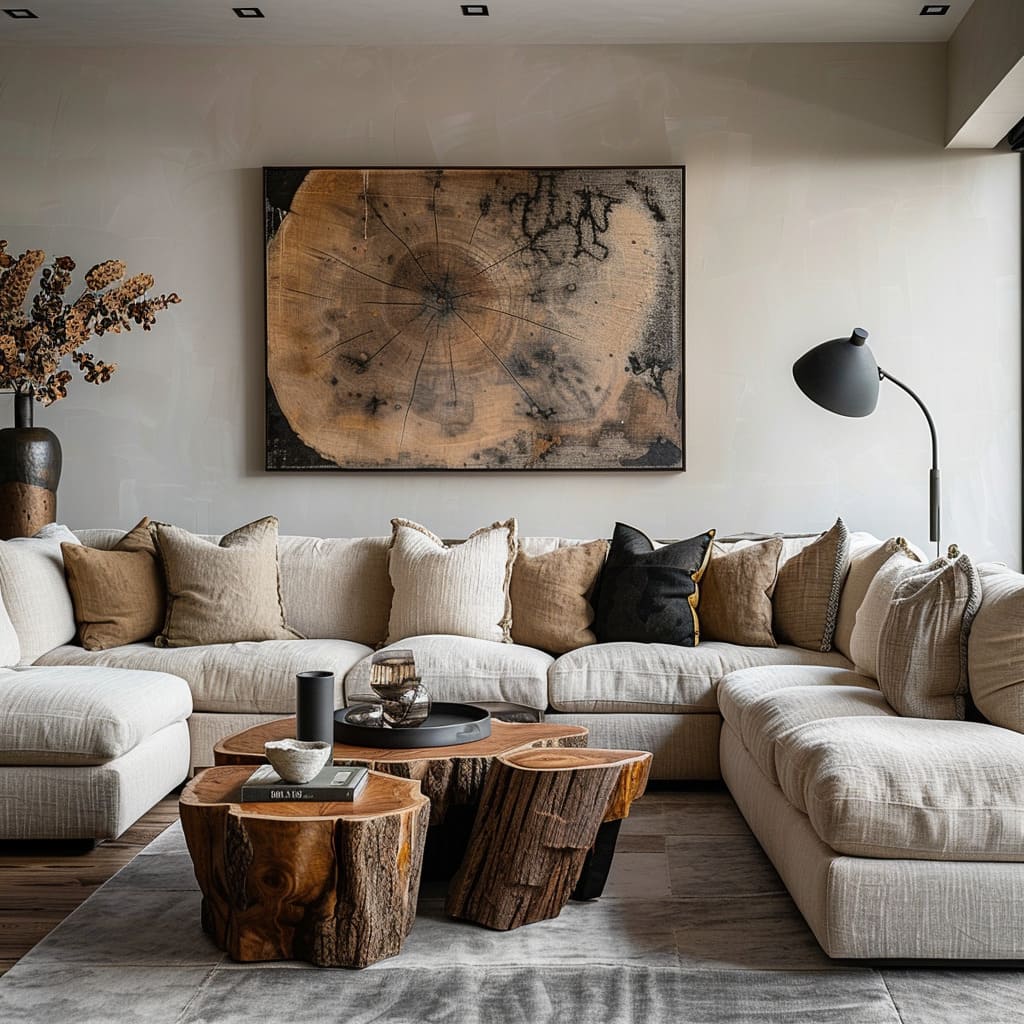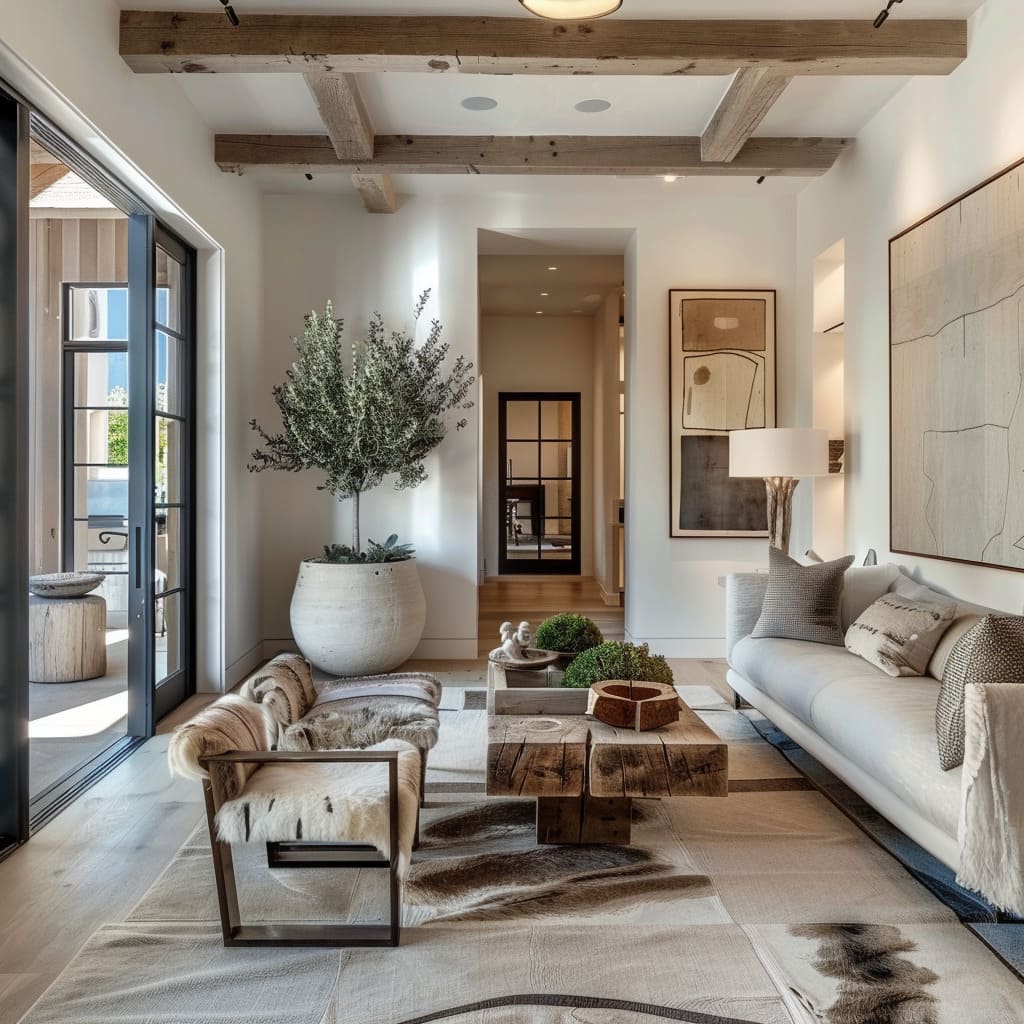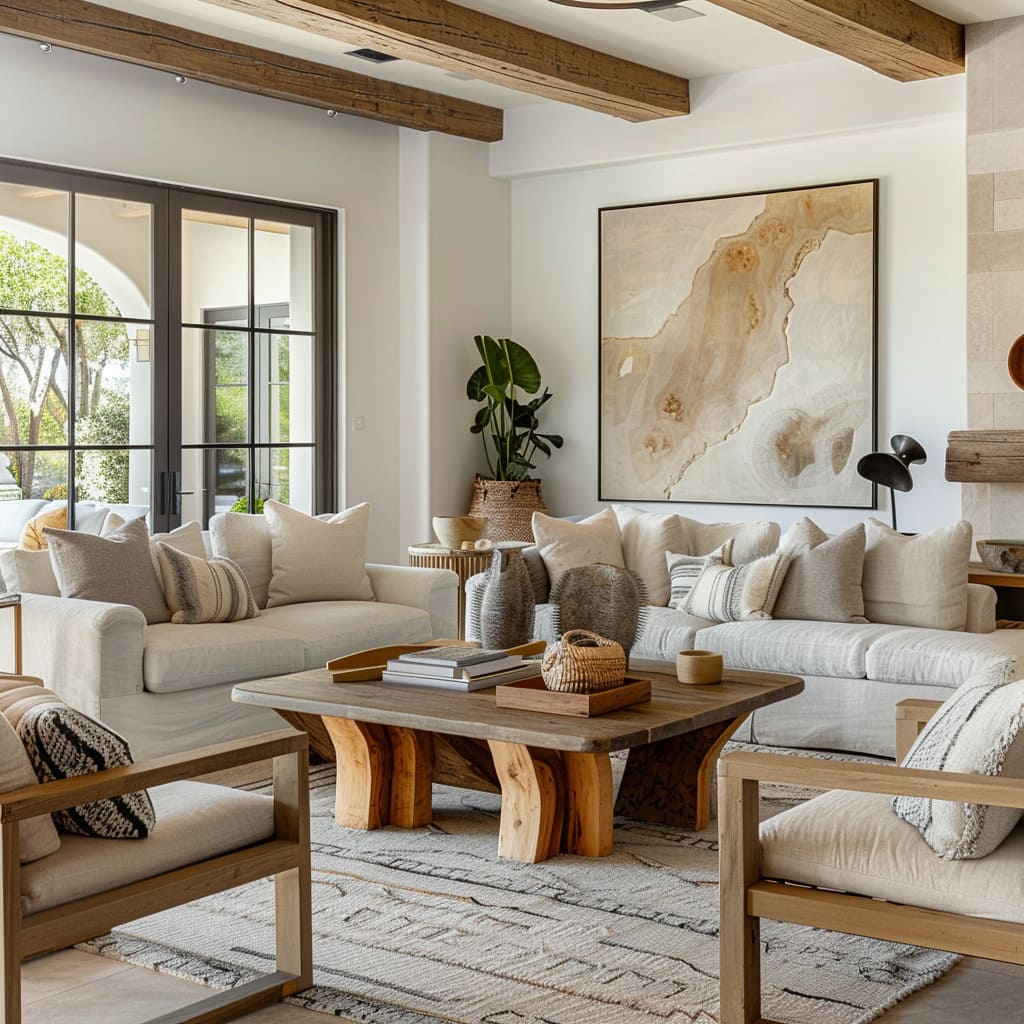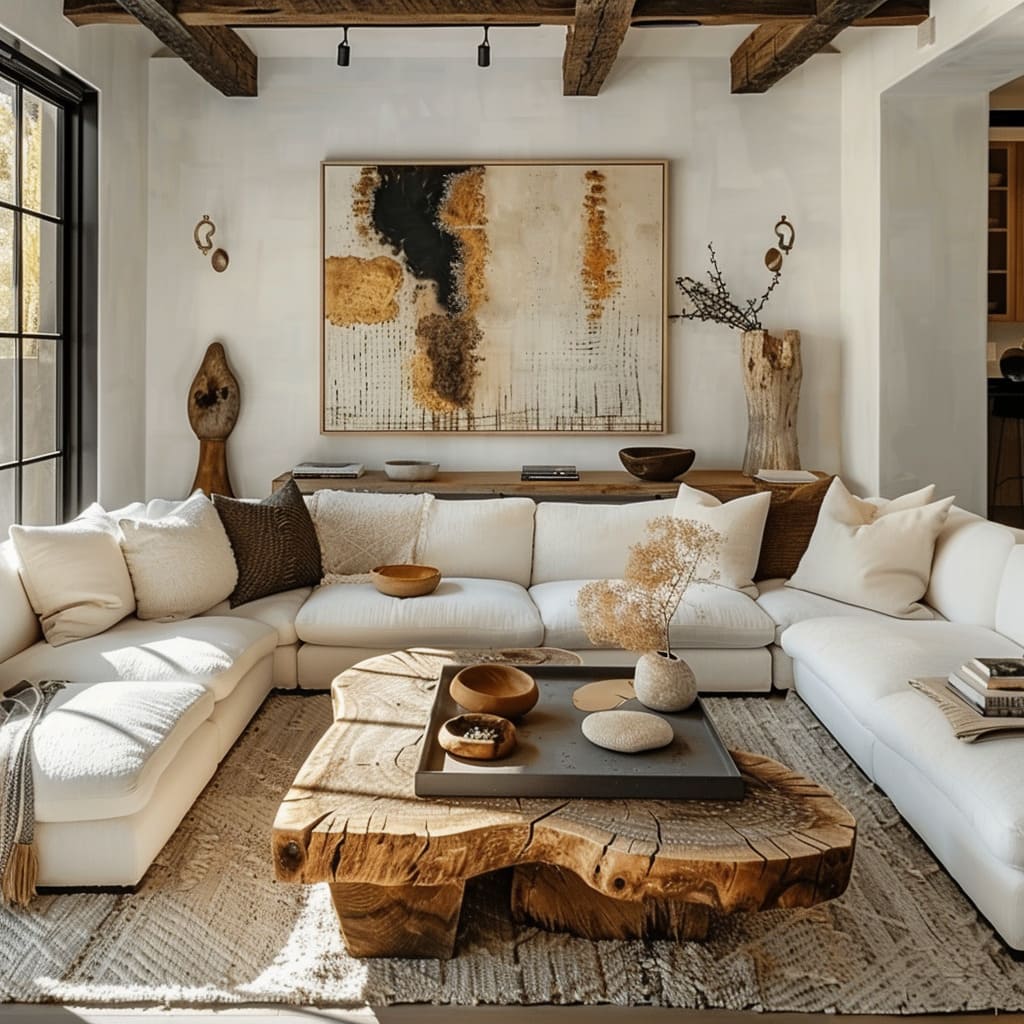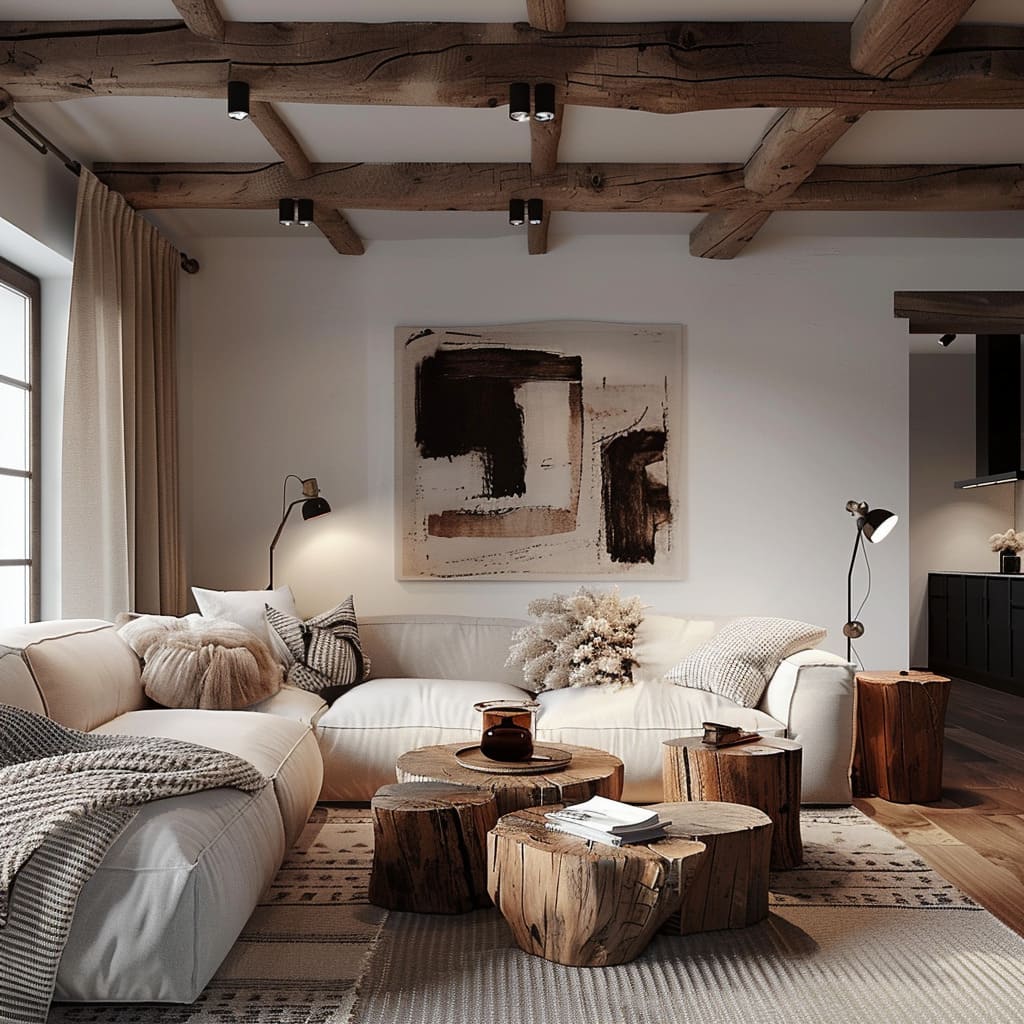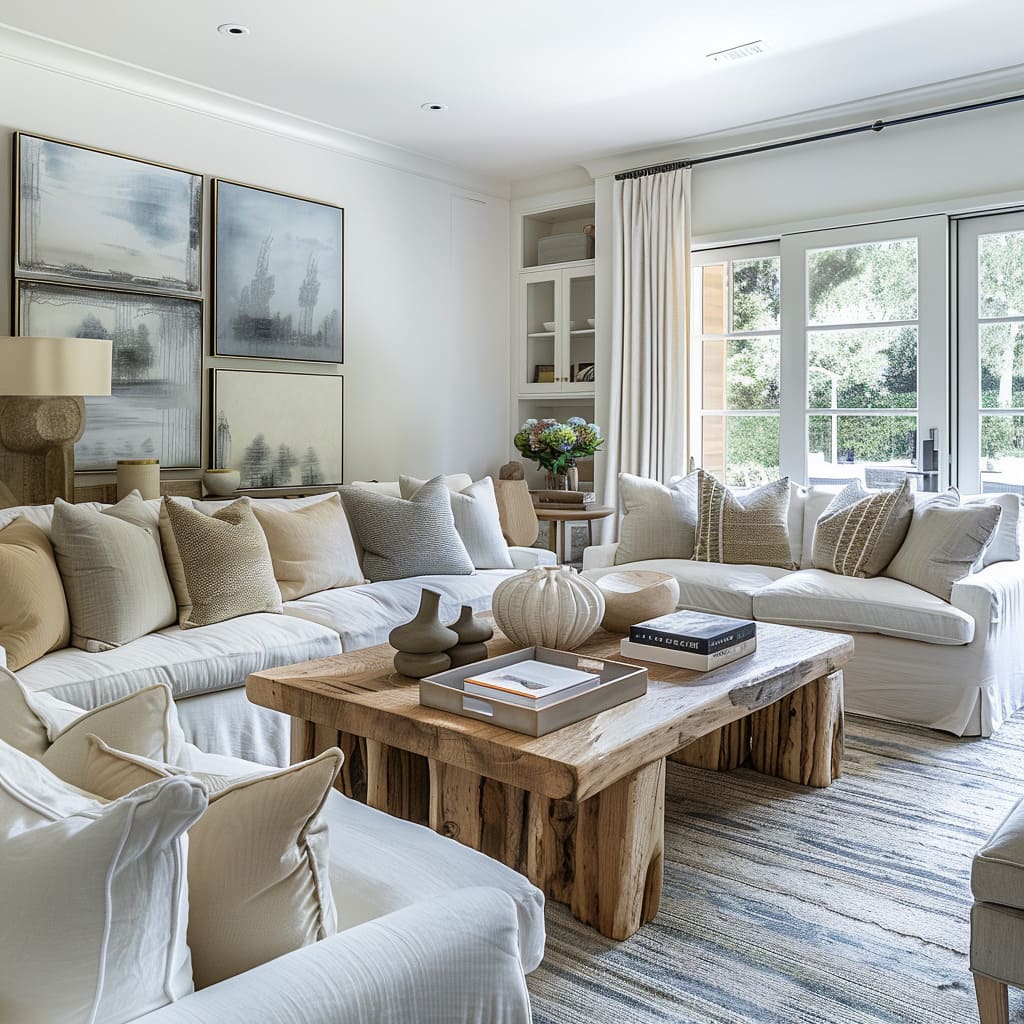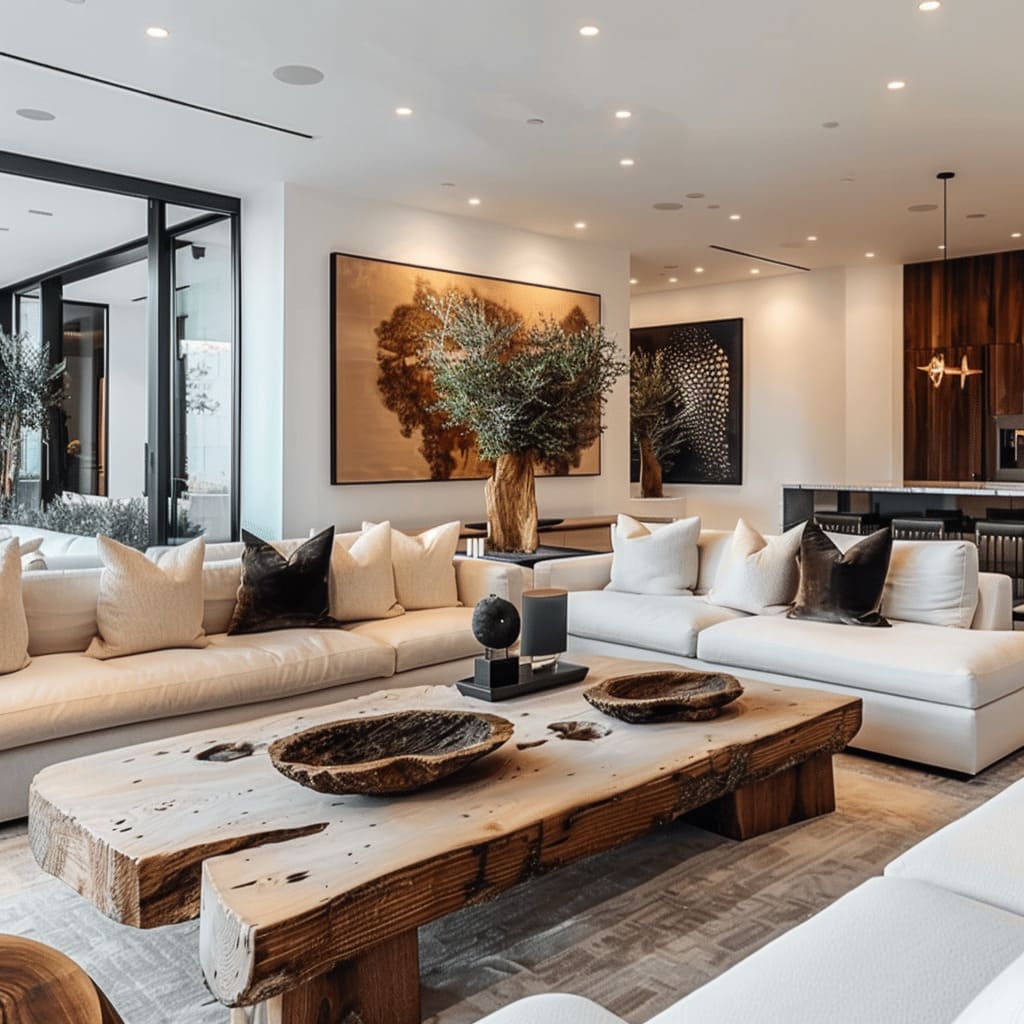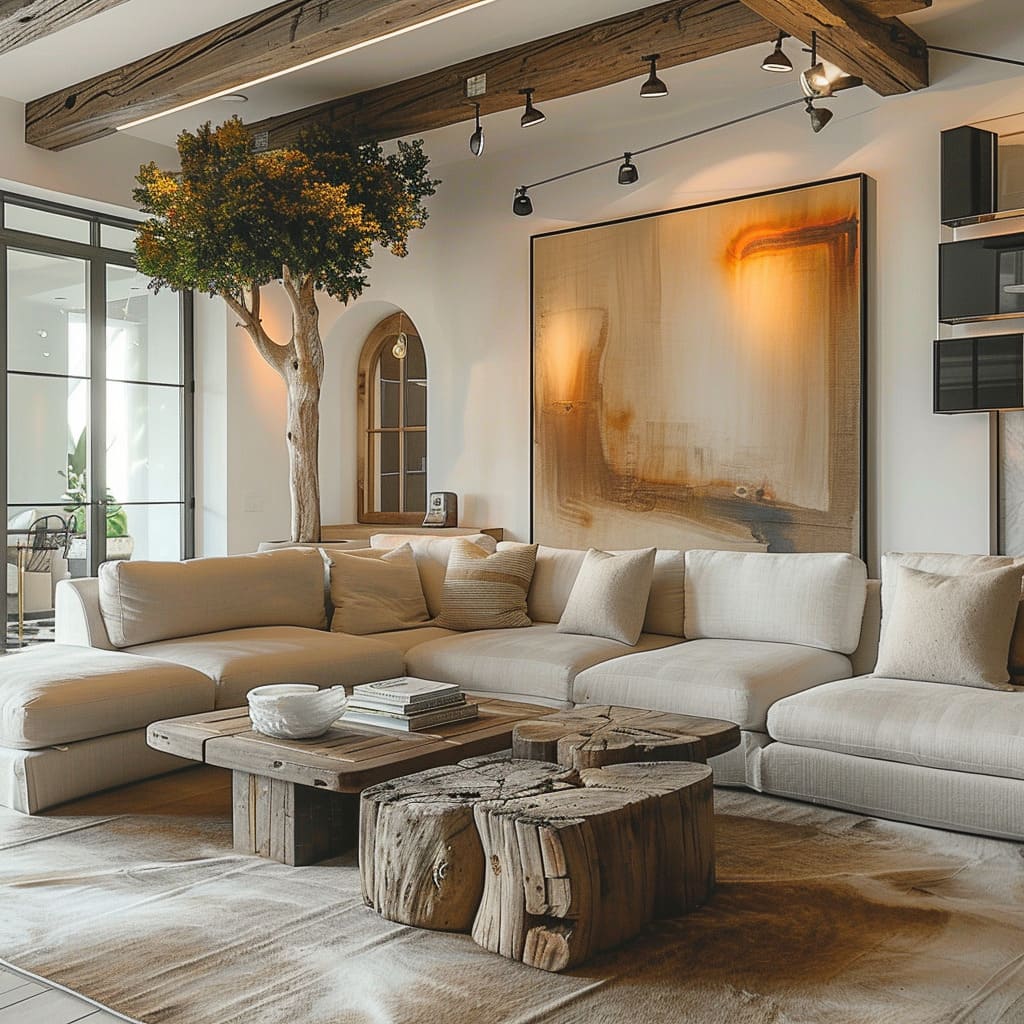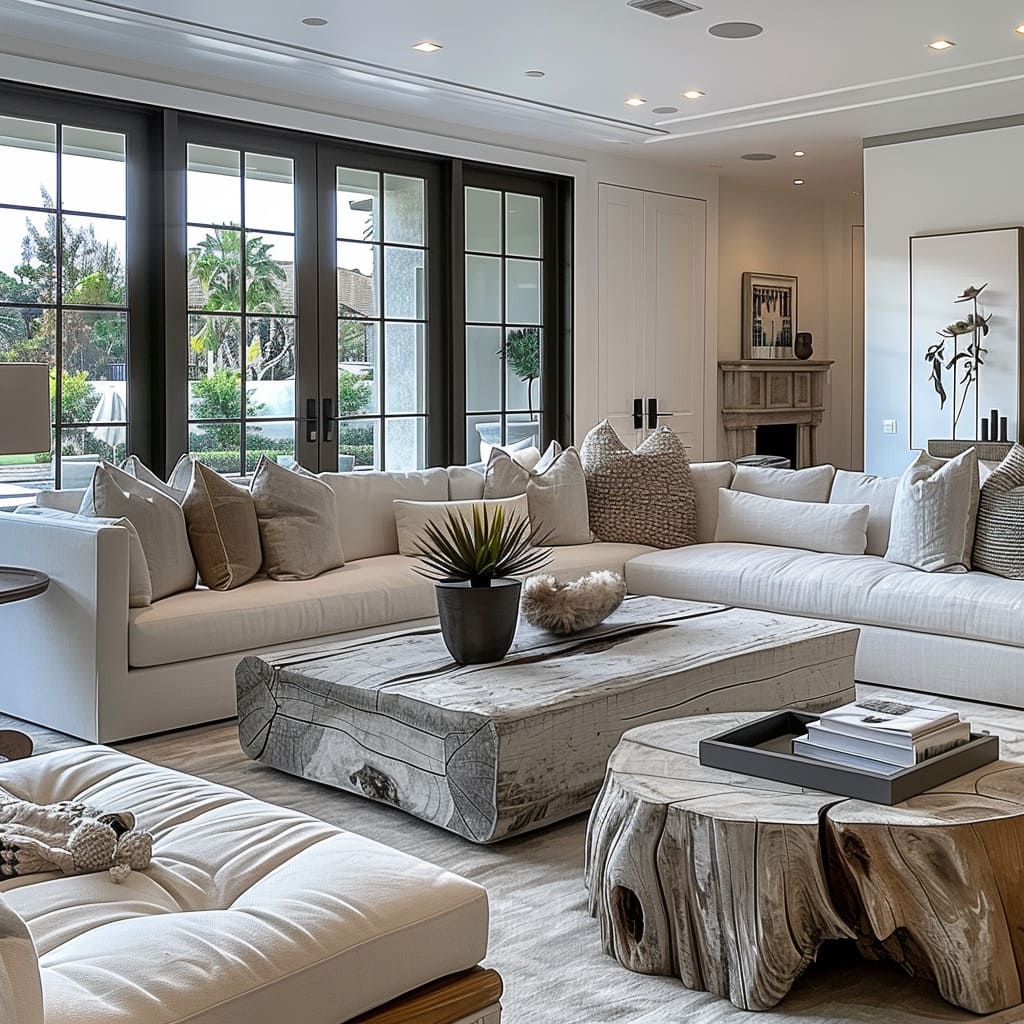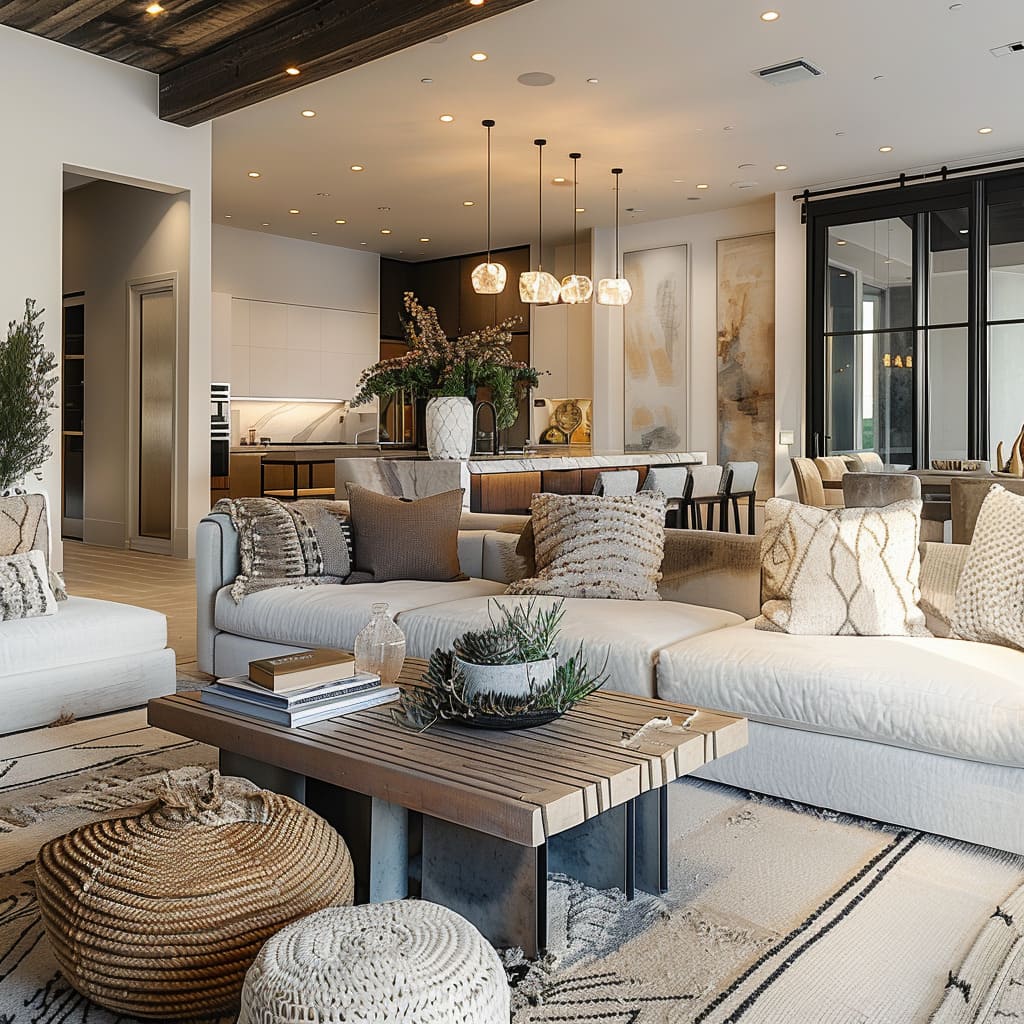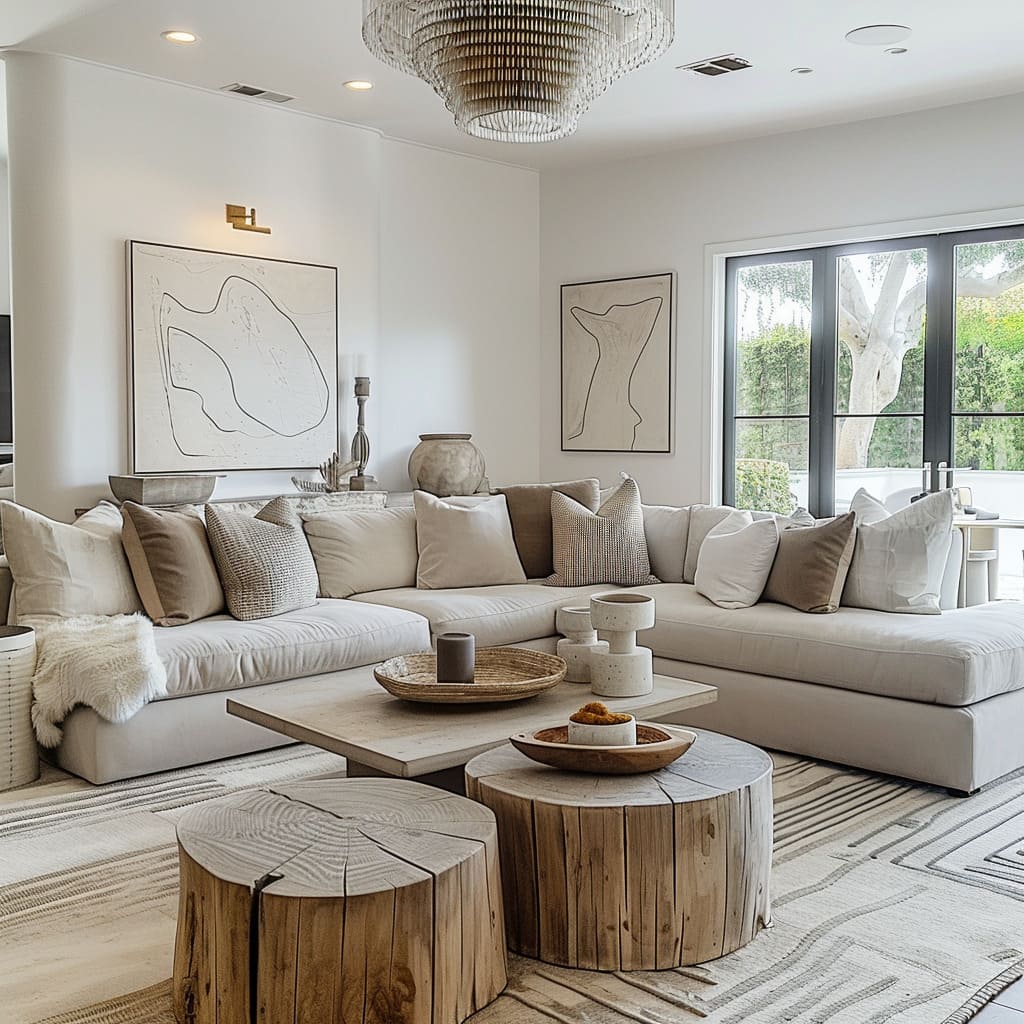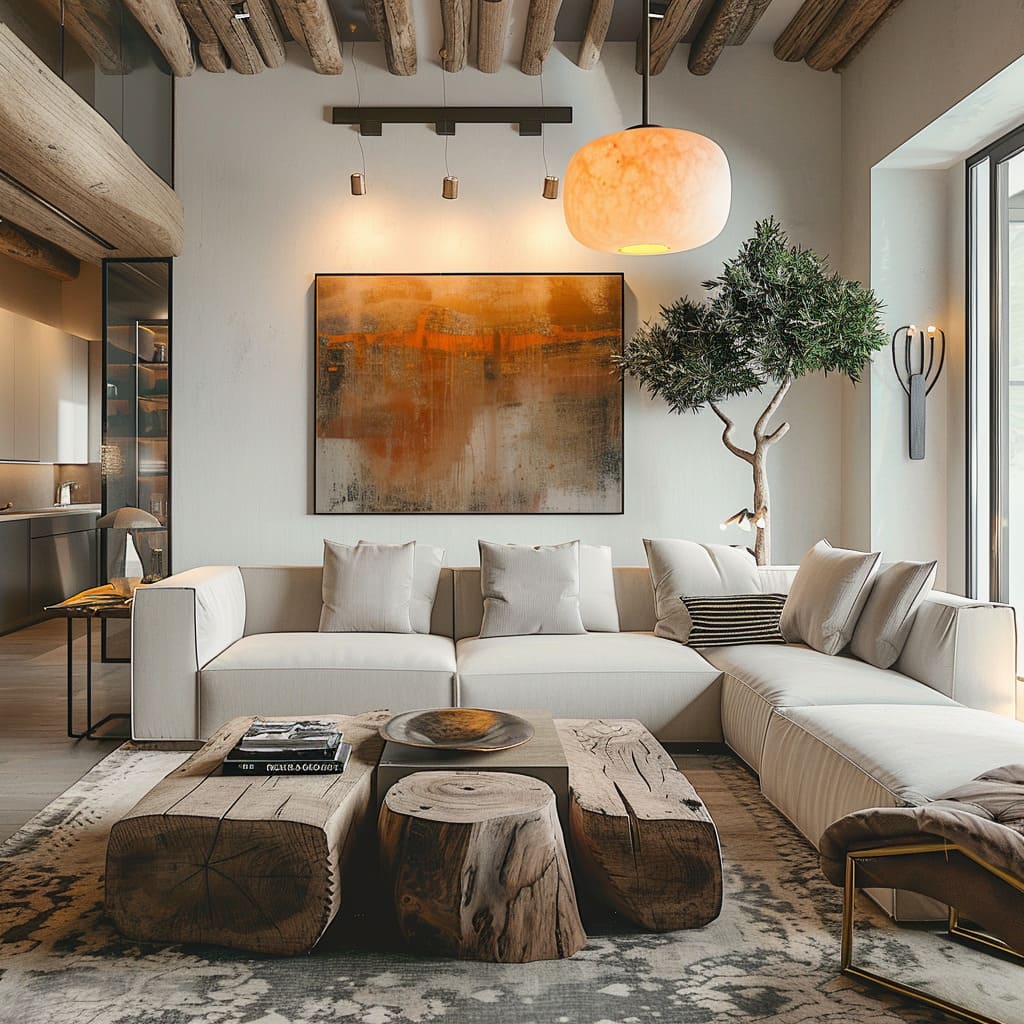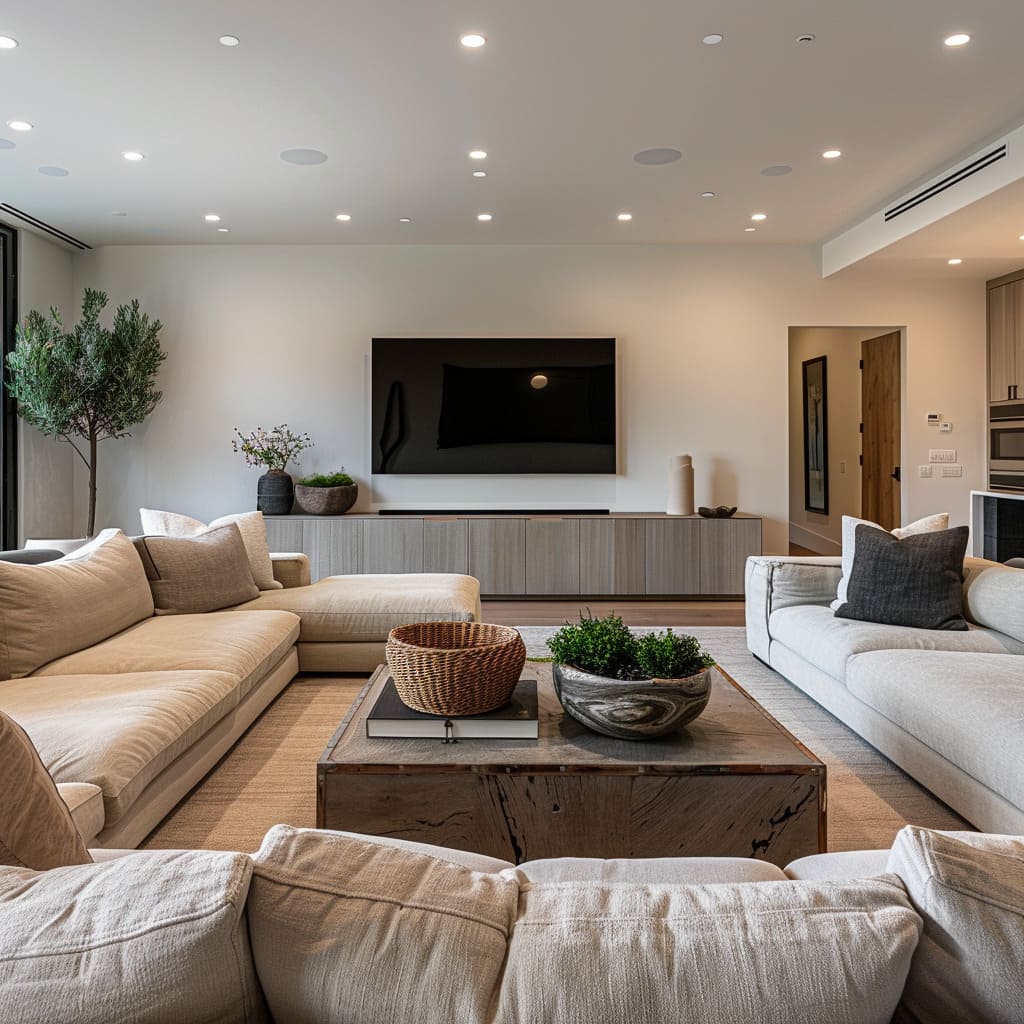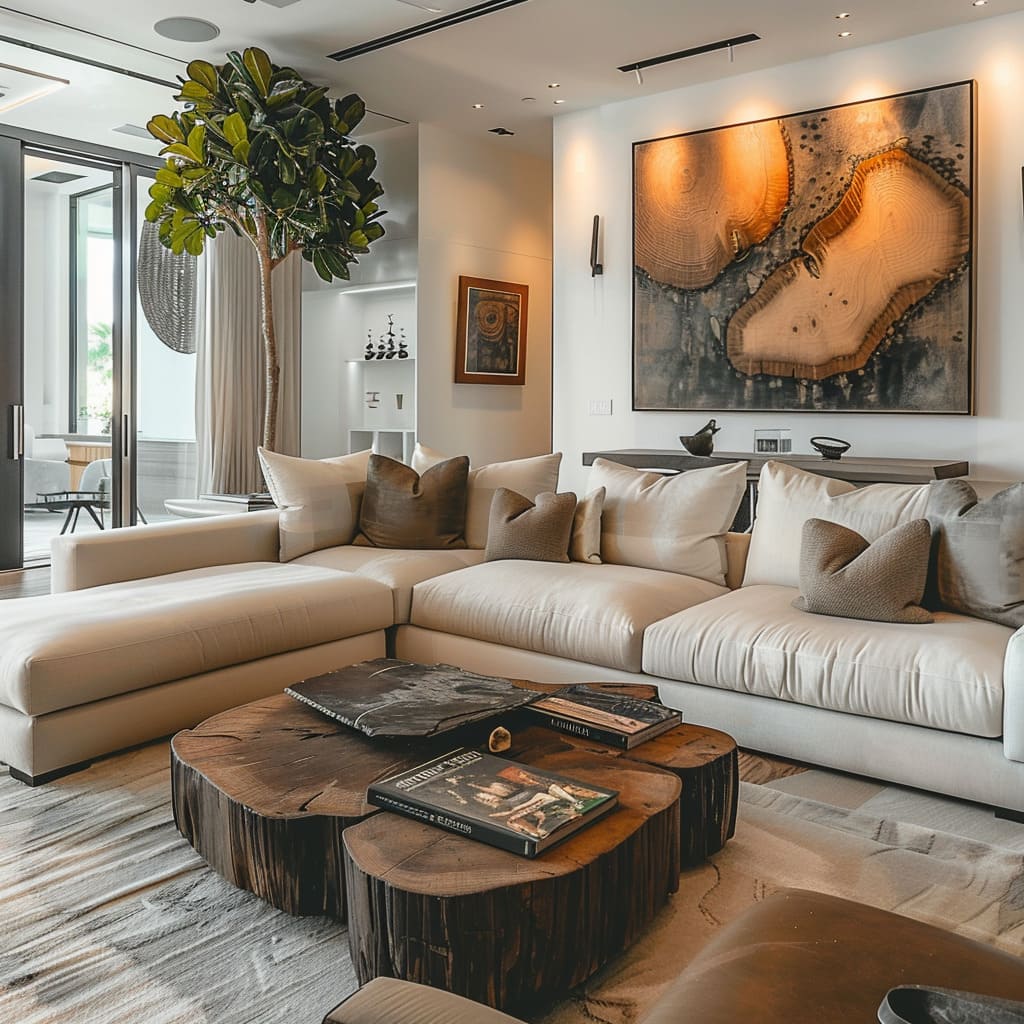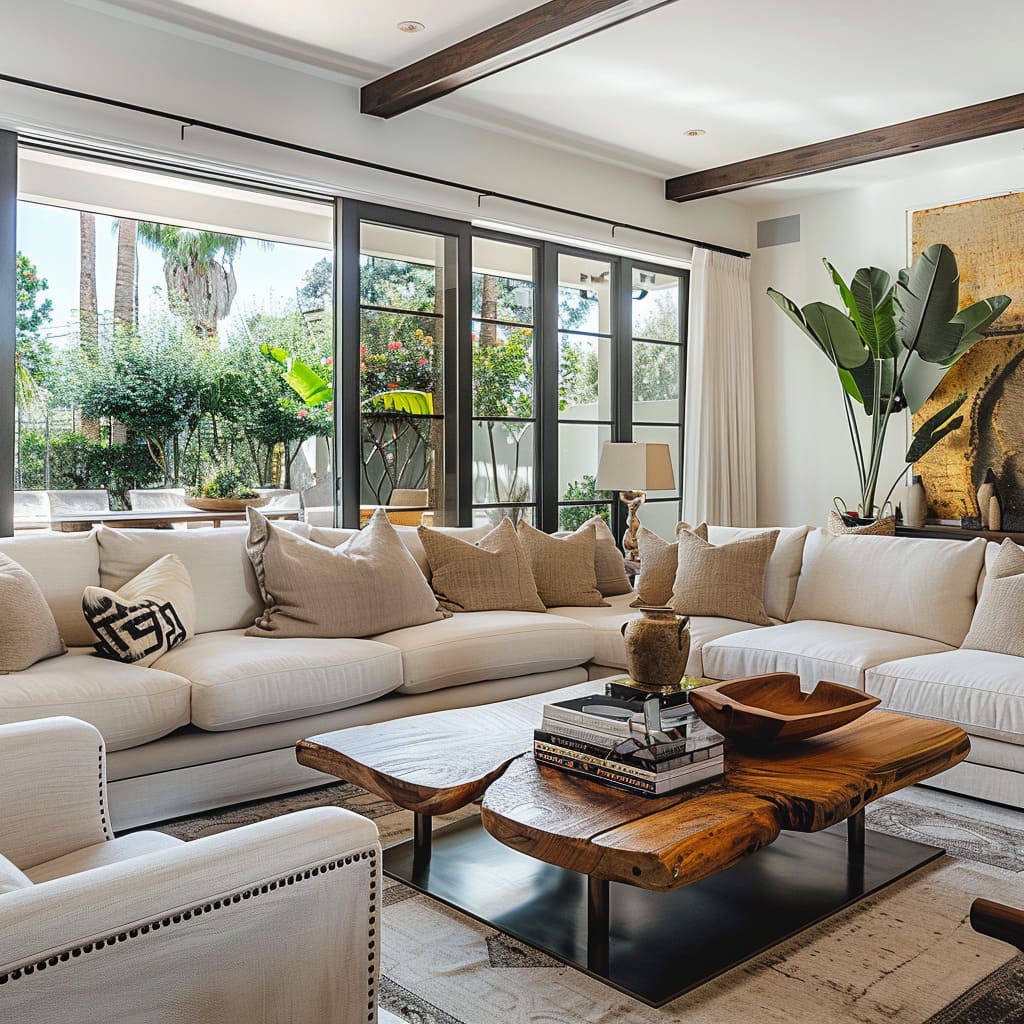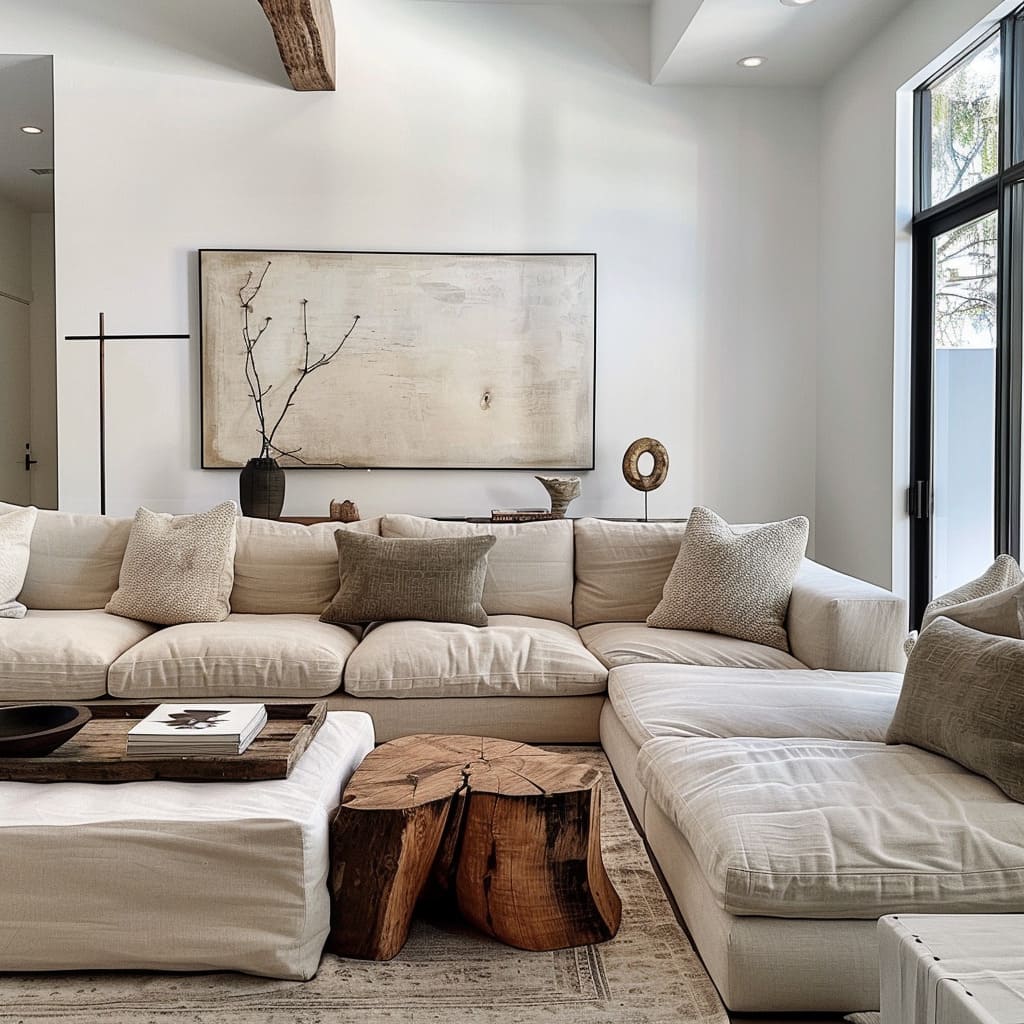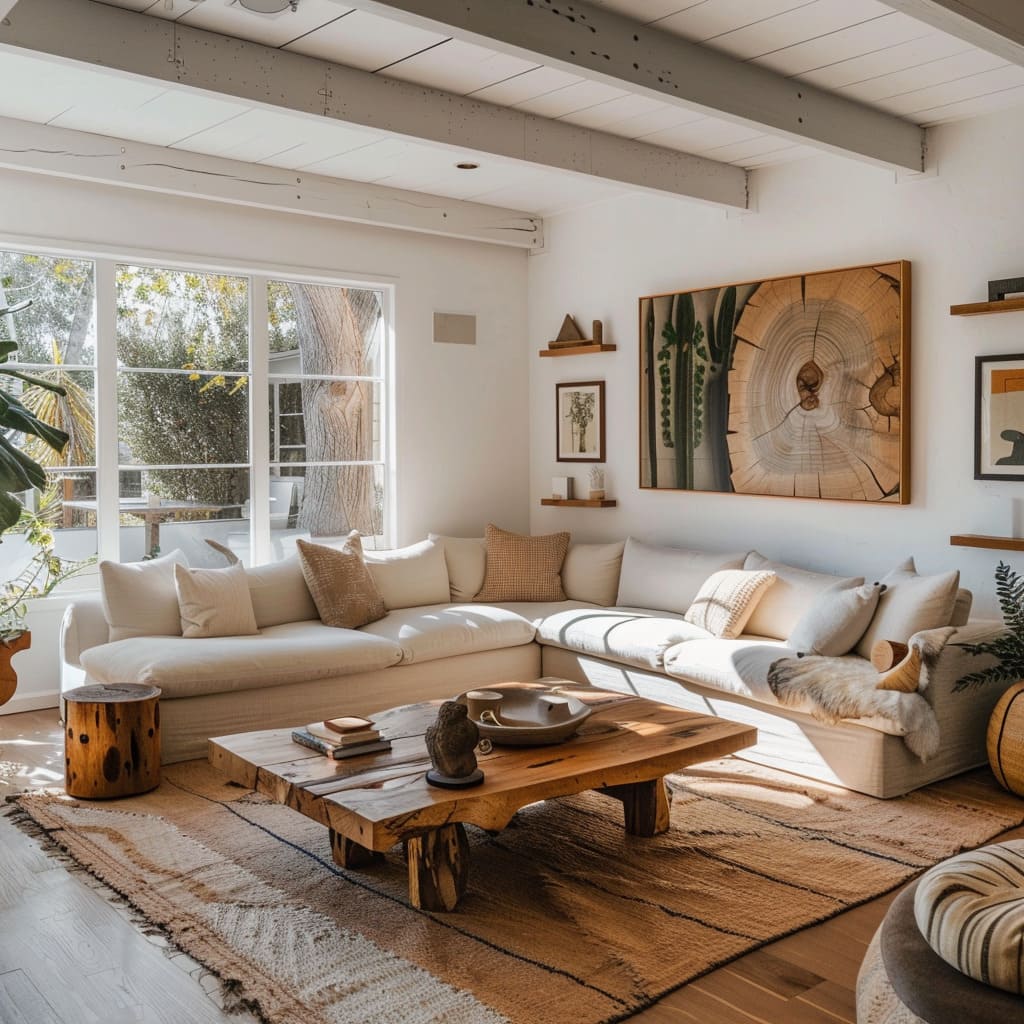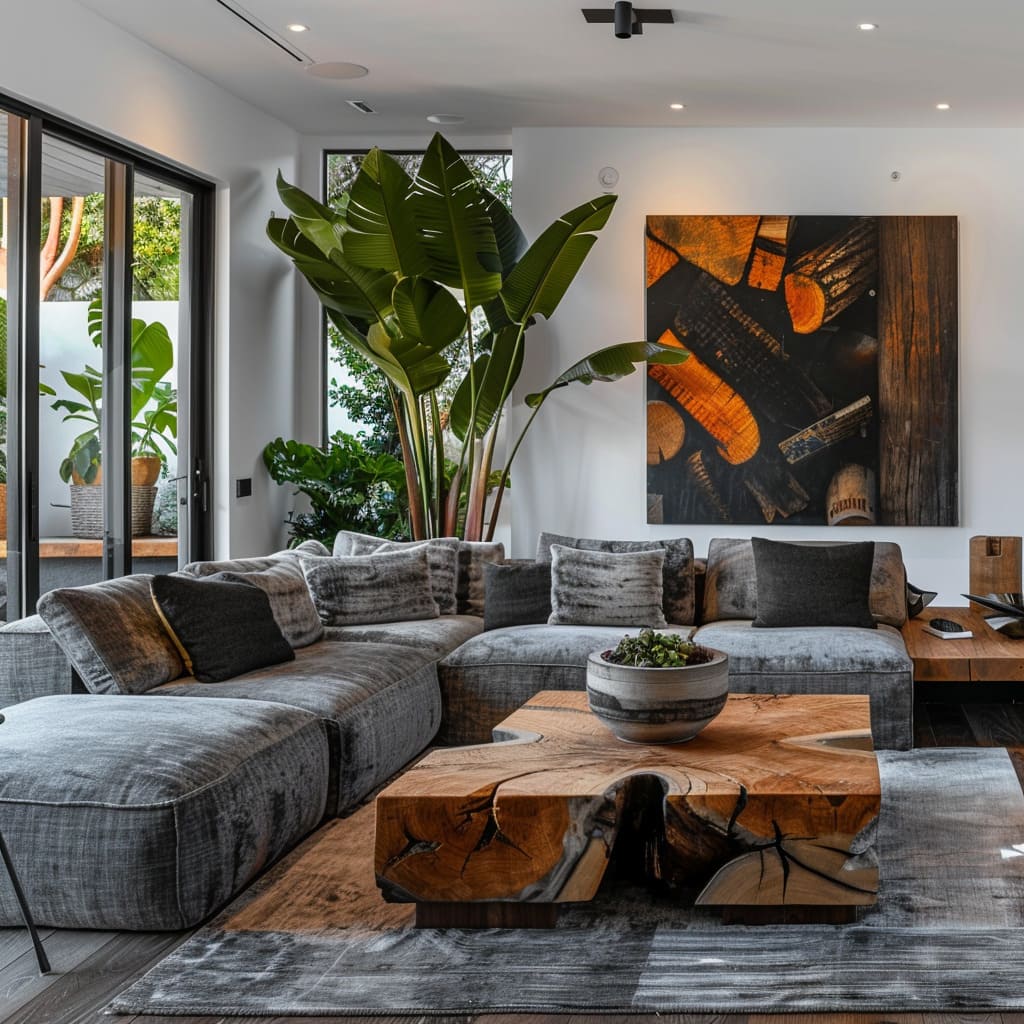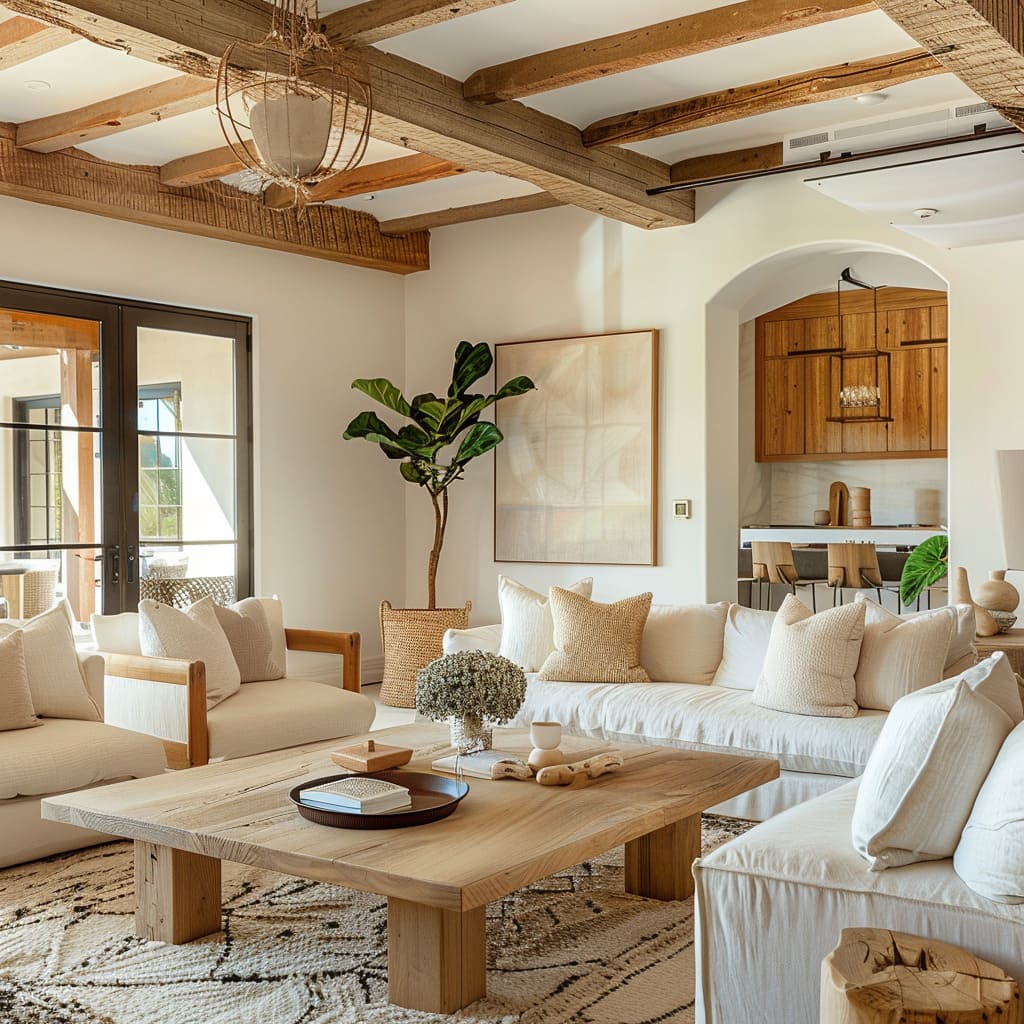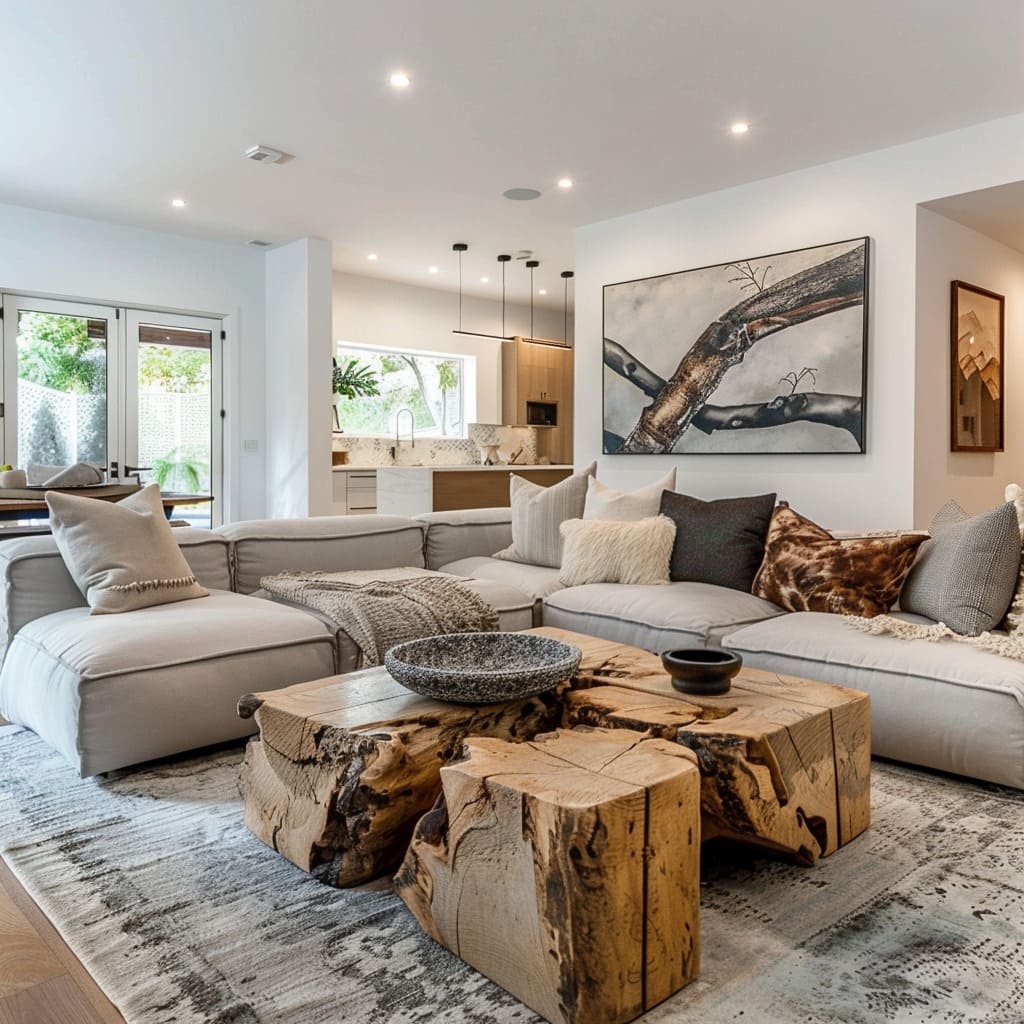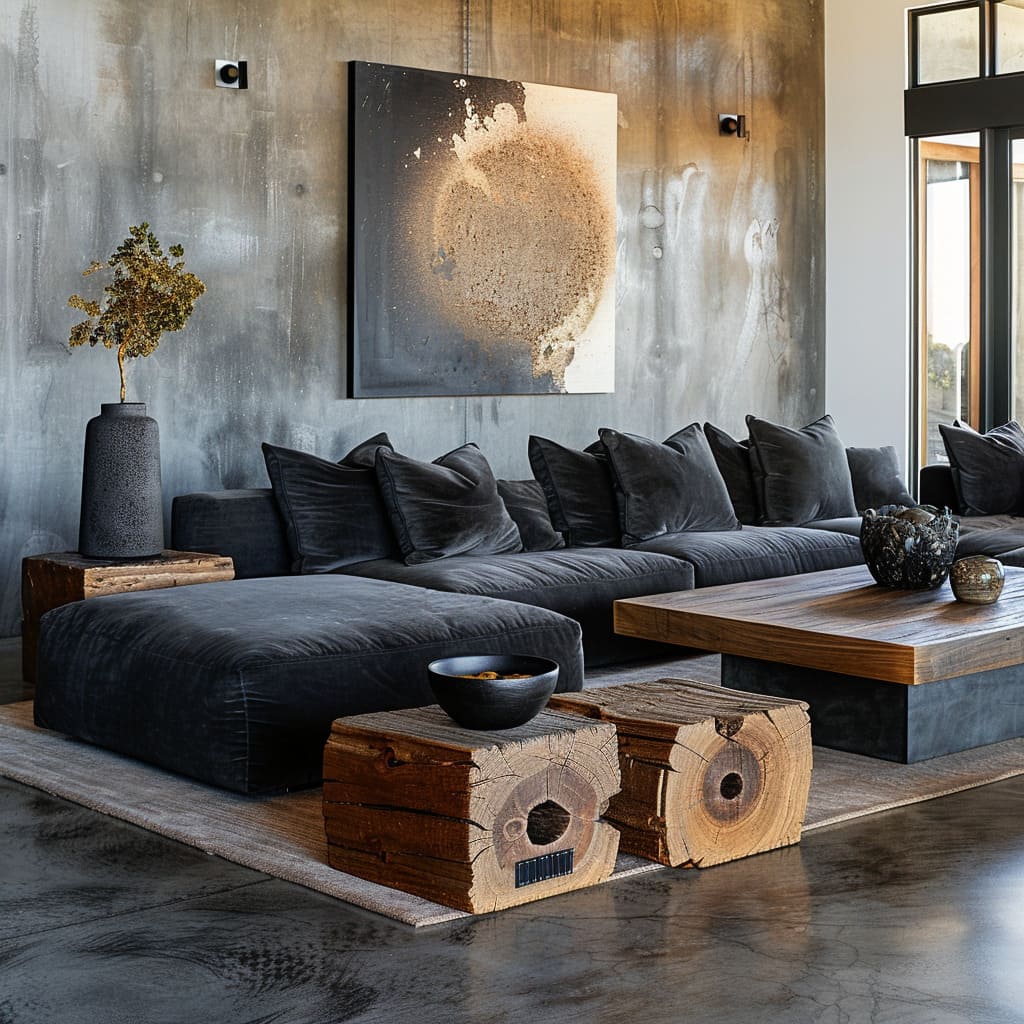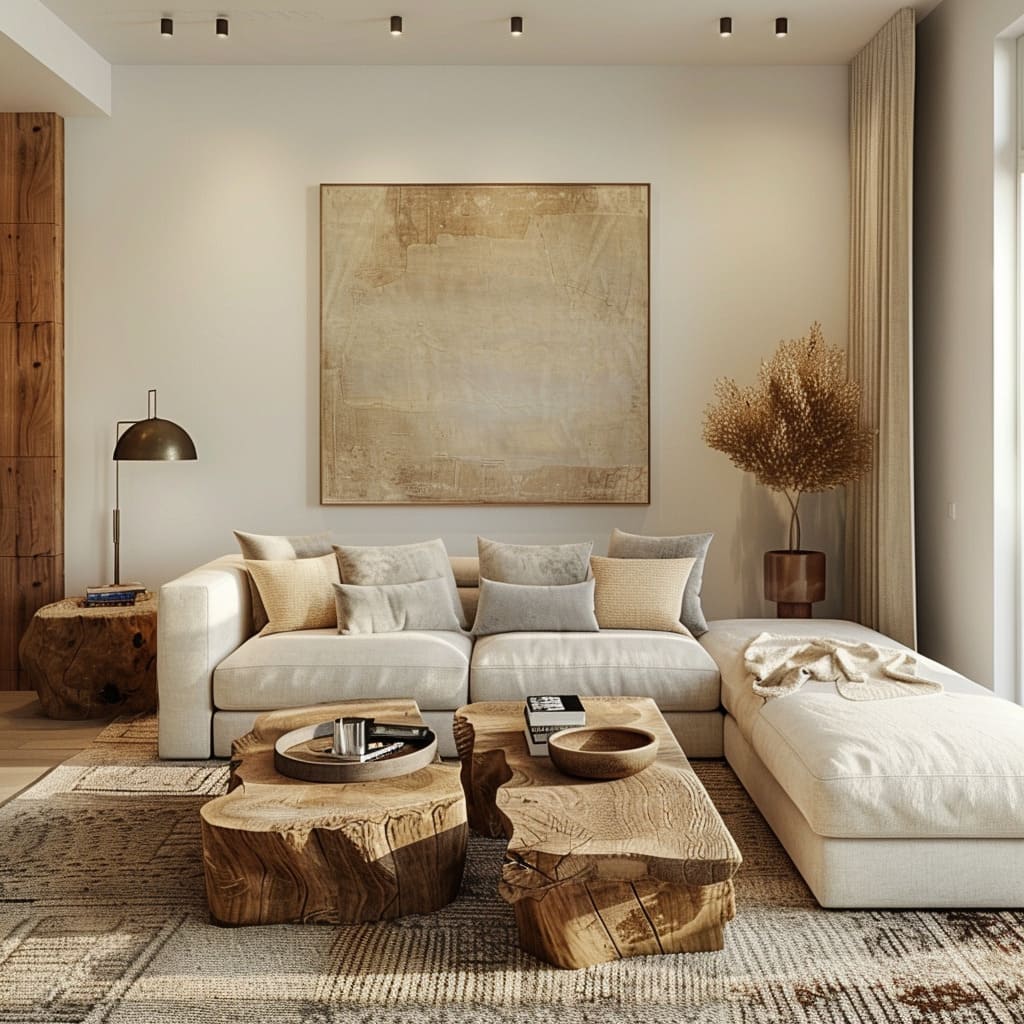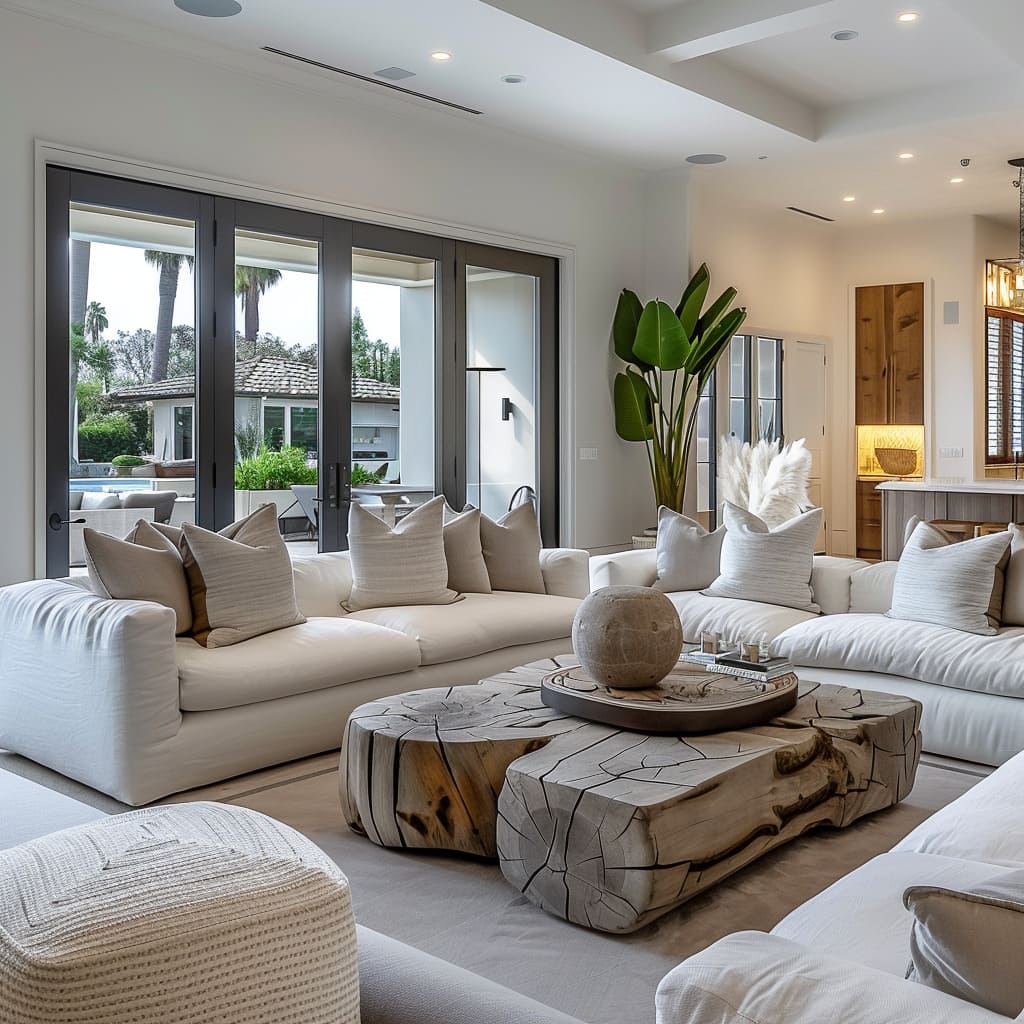Interior design continually evolves, yet the incorporation of natural elements remains timeless, particularly through the use of live-edge wood and logs. These materials are celebrated for their organic beauty and the distinctive aesthetic they bring to both residential and commercial spaces.
This introduction to the wondrous world of live-edge wood explores its functionality, aesthetic appeal, and the profound connection it fosters between nature and human-made environments.
Live-edge wood pieces are not only striking but also deeply connect with the natural world, making them a popular choice for those looking to infuse their spaces with a sense of tranquility and raw beauty. By maintaining the original lines and contours of the tree, each piece offers a unique story and an unreplicated visual appeal that can complement a variety of interior styles—from rustic to contemporary.
This approach not only highlights the intrinsic beauty of the wood but also honors its origin, adding layers of depth and character to the design.
Furthermore, the use of such wood supports sustainable design practices. Sourcing from local woods reduces environmental impact and supports local economies, aligning with the growing trend towards eco-friendly and sustainable interior design.
Live-edge wood is often seen in key furniture pieces such as tables, desks, and shelving—each serving as a focal point that naturally draws the eye and anchors the room.
As we delve into the specifics of how live-edge wood and logs are utilized in interior design, we will explore various aspects including their connection to biophilic design principles, historical significance, and their role in creating dynamic and inviting spaces. Through this exploration, we’ll see how these elements not only enhance the aesthetic value of a space but also its functionality and emotional resonance, proving that the beauty of nature can transform any interior into a more inviting and inspiring environment.
The Essence of Nature and Craft
In this section, we reflect on how the raw elegance of wood shapes the space’s core, connecting inhabitants to the natural world while exhibiting human ingenuity.
Connection to Nature
Live-edge wood, by preserving the original outlines and textures of trees, serves as a visceral reminder of the verdant landscape from which it originates. This incorporation of natural elements fosters an intimate bond with the environment, seamlessly blending the outdoor beauty with the interior’s ambience.
Organic Forms
The retention of a tree’s inherent contours within live-edge wood offers an organic presence that introduces an element of the unforeseen into the design. Its asymmetrical allure bestows the living room with a distinctive personality, an echo of nature’s spontaneous artistry.
Raw Beauty
The untouched or minimally altered wood reveals a stark, captivating allure that stands in stark contrast to materials overly processed or synthesized. This raw aesthetic speaks to a longing for authenticity, a tangible piece of nature amidst our modern constructs.
Sustainability
The choice of natural and, where possible, locally harvested wood, can signal a dedication to sustainable practices in home design. This decision resonates with a growing consciousness towards responsible sourcing and the impact of our choices on the environment.
Biophilic Design
The integration of live-edge wood is not merely a stylistic choice but a fundamental aspect of biophilic design, which aims to foster a deep-seated connection between humans and the natural world. By inviting elements such as these into our spaces, we cultivate an environment that resonates with our intrinsic affinity for nature.
The Art of Time and Tradition
Here, we delve into the historical and cultural resonance of wood in design, and how its evolving nature over time enhances the environment it inhabits.
Historical Reference
Incorporating raw wood forms can reference historical building techniques and materials, grounding the space in a sense of time.
Cultural Significance
The materials selected for living spaces do more than fill a functional need; they resonate with the resonance of cultural heritage. Various woods bear the marks of the localities they come from, drawing a silent lineage to age-old craftsmanship and regional lore.
They introduce a layer of depth to the living space, connecting residents to a lineage of woodworkers whose expertise has been refined over centuries.
Aging Gracefully
Wood, as a living material, matures and develops a patina, contributing to a living design aspect that evolves and enhances over time. This progression lends a narrative to each piece, revealing the passage of time not as a force of decay but as an accumulation of life and character.
Heirloom Quality
The furnishings crafted from noteworthy pieces of wood often rise to the status of the room’s visual anchor. These pieces, replete with story and stature, have the potential to become cherished heirlooms, traversing the continuum of family history, accumulating sentimental value with each changing hand.
Reclaimed Stories
Incorporating reclaimed wood is not simply an environmentally considerate choice but a method of infusing the living space with chronicles of the past. Each mark and grain pattern in reclaimed wood narrates a distinct tale, making its presence a compilation of stories rather than a mere object occupying space.
The Dynamics of Space and Perception
We examine the influence of wood on the perception and flow of space, focusing on its contribution to the visual and acoustic experience within interiors.
Visual Weight
In interior settings, substantial wooden pieces, be it a hefty table or sections of logs, act as anchors in the spatial composition. They command attention, serving as the room’s sturdy counterparts to more ephemeral elements.
These robust components offer stability to the living area’s aesthetic equilibrium, inviting the gaze to rest, and providing a counterbalance to lighter, more delicate objects.
Play of Shadows
The uneven silhouettes and textures of natural wood introduce a dynamic theatre of shadows, varying with the day’s changing light. As sunlight or ambient illumination shifts across these surfaces, they cast a cavalcade of shapes that dance across the room, lending a quiet movement to the still air of the space.
Acoustic Qualities
Wood’s natural properties extend beyond the visual; they touch the realm of the sonic. In a room, wood can mellow harsh sounds, contributing to a soft auditory backdrop.
The quality of sound within a space, affected by materials such as these, is an undercurrent that subtly shapes the sensory experience of an environment.
Visual Flow
The organic edges of a live-edge element guide the observer’s eye in an uninterrupted journey around the room. The way these lines meander influences the room’s kinetic quality, directing movement and creating a seamless transition from one area to another, lending a sense of cohesion to the room’s design.
Interplay with Light
Natural wood engages with light in a manner distinct from its artificial counterparts, possessing the ability to alter a room’s atmosphere. It can reflect soft, diffused light or absorb it, casting a warm or cool tone throughout the space.
This interaction contributes significantly to the mood within the living area, setting the stage for a variety of ambiences depending on the time of day and the quality of light present.
The Interaction of Textures and Materials
This discussion centers on the interplay between the tactile qualities of wood and other materials, creating a rich tapestry of textures that appeal to the senses.
Textural Depth
The tactile surface of wood, replete with grooves and the distinct patterns of its growth rings, introduces a variety of sensations underhand. This textural diversity adds layers to the living space’s experience, encouraging touch and close inspection.
These natural textures draw a stark difference from the monotony of overly smooth, featureless materials, allowing the essence of nature to manifest through every ridge and furrow.
Tactile Contrast
Wood with an unrefined finish presents a stark contrast to the sleek textures commonly found throughout modern interiors. It invites a dialogue between the coarse and the smooth, between the organic and the man-made.
Such juxtapositions are not just a feast for the eyes but a conversation of textures to be experienced through touch, adding richness to the interior tapestry.
Fusion of Materials
Integrating live-edge wood with elements such as glass or metal juxtaposes the rustic charm of nature with the clean lines of modern industry. This interplay brings forward a balanced synergy that honors the rawness of nature alongside the precision of modern manufacturing.
It’s a celebration of disparate origins, converging in a space that respects the essence of each material. If you love farmhouse style intriors, explore the fusion of simplicity and sophistication with rustic elegance in modern farmhouse interiors.
Color Variation
The natural spectrum of wood hues offers a visual symphony of earthy tones, ranging from the light, almost golden hues of sapwood to the deeper, richer shades of heartwood. This innate palette harmonizes effortlessly with a variety of color schemes, providing a grounding effect that can either complement or pleasantly contrast with other design elements in the room.
Imperfections as Features
The unique characteristics of wood, such as knots, grain irregularities, and fissures, are not merely tolerated but revered. These features are often emphasized to showcase wood’s natural journey and history, revealing a narrative of growth and survival.
By foregrounding these characteristics, the design invites an appreciation for the imperfect and the storied, fostering an environment where authenticity is the cornerstone.
Functional Elegance and Adaptability
Considerations of functionality, adaptability, and the less formal aspects of wood use are the focus here, revealing how they contribute to a living space that is both beautiful and practical.
Durability
Solid wood brings not just an aesthetic appeal but also an enduring presence to living spaces. Its robust nature ensures longevity, capable of withstanding the ebb and flow of daily life.
The resilience of raw wood is one of practicality; it stands as a testament to the enduring nature of organic materials, outlasting trends and minor impacts with ease, maintaining its integrity over the years.
Design Flexibility
The versatility of log sections and live-edge slabs extends into their ability to be transformed and reimagined into various forms.
This flexibility allows for an evolutionary approach to design, where pieces can be altered, resized, or repurposed to fit changing needs or styles. Such adaptability makes them a wise choice for those who value an interior that can transition as life unfolds.
Versatility
Whether one’s style leans toward the traditional warmth of a classic aesthetic or the clean lines of a contemporary approach, natural wood elements find their place. Their versatility lies in their ability to bridge styles, bring warmth to minimalist settings, or add a modern twist to classic interiors.
They are chameleons of design, seamlessly fitting into a multitude of environments.
Informal Elegance
The inherent roughness of wood may suggest a casual, more laid-back vibe, yet when placed within the context of a thoughtfully designed room, it achieves an effortless elegance. This blend of relaxed aesthetics with refined design creates a living space that is inviting and sophisticated, proving that comfort and grace can coexist beautifully.
Seasonal Adaptability
The hues and textures of wood lend themselves to a fluid adaptation to seasonal decor shifts. In colder months, they can bring a sense of warmth and shelter, while in the brightness of summer, they can ground the space without overpowering it.
This ability to harmonize with seasonal themes makes wood an excellent choice for those who enjoy updating their living spaces to reflect the time of year.
Unique Narratives and Personal Touches
This section is dedicated to the stories that live-edge wood elements tell, the personalization they offer, and the distinct visual narratives they create.
Craftsmanship
The process of shaping live-edge and rough-hewn wood into functional art pieces is a meticulous labor of love, showcasing the skilled labor and attention to detail of artisans. Each cut, each sanding stroke, and each finish application is a step towards crafting a unique item.
This craftsmanship is evident in the smoothness where hands will touch and the preserved ruggedness of bark edges, revealing the material’s origin.
Uniqueness
Furniture fashioned from live-edge wood is inherently distinctive.
Each piece bears its individual narrative through its grain, knots, and natural lines, ensuring that no two pieces could ever be identical. This uniqueness confers a level of personalization and exclusivity within the living space, imbuing it with a character that is as singular as the tree from which it came.
Warmth
Wood, with its innate tones and textures, acts as a natural insulator of warmth, fostering an inviting atmosphere. It counteracts the coolness of stone, metal, and glass, balancing the temperature in the living area both physically and visually.
The presence of wood can make large spaces feel cozy and small spaces appear to embrace their occupants.
Sensory Experience
The introduction of wood into a space activates the senses: the distinctive scent that evokes forests or the warmth of a craftsman’s workshop, the feel of grain patterns against fingertips, the visual appeal of natural tones and textures.
These sensory details come together to enhance the living experience, connecting occupants more closely with their environment.
Rustic Influence
Incorporating elements like live-edge wood and logs adds a rustic allure that stands in stark relief against the sleek modernity of contemporary decor. This rusticity infuses a room with a sense of groundedness, offering a tactile and visual break from the uniformity of machine-made surfaces and imbuing the space with a down-to-earth, inviting vibe.
By examining these features, one can appreciate the manifold ways in which live-edge rough wood and logs not only serve functional purposes but also bring a multifaceted richness to interior spaces. Each characteristic weaves into the others, creating a comprehensive tapestry that defines the space’s aesthetic and atmosphere.
Find more interior design ideas with live edge wooden furniture in this article.


